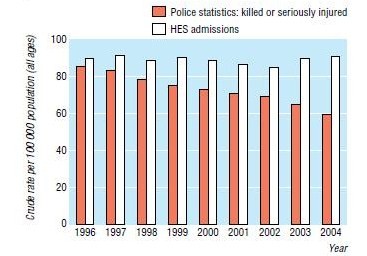Why road casualties don't add up
This week the Statistics Authority published a critical assessment of road casualty statistics. If things didn’t improve, they said, these figures would have to be renamed “Police-recorded road casualty statistics” – with the pretty clear implication that what the police recorded was some way from the full picture. So what’s going on?
The Department for Transport has known for some time that police figures undercount road casualties. But as long as the level of undercounting remained stable, it seemed reasonable to keep using them to monitor trends. Things changed in 2006 when a group of three public-health experts, led by Michael Gill of the Public Health Group of the Government Office for the South East, published a paper in the British Medical Journal, in which they claimed that the undercount is getting worse.
They looked at the number of patients admitted to hospital after a road traffic accident and kept in for at least one night: unlike the police count of accidents and fatalities, this figure has changed little in recent years. And they pointed to the fact that deaths due to accidents on the road, which are unambiguous and almost always show up in police figures, have fallen much less than police-recorded non-fatal injuries. Here is their illustation of the trend, comparing police statistics with admissions for traffic injuries from hospital episode statistics (HES).

The two sets of figures had clearly started diverging. The Statistics Authority is now worrying about this unmooring, too. In its assessment of the Department of Transport’s road casualty statistics published on July 27, it said that in future the figures should include an estimate of under-reporting, and that police should try harder to report more accidents, and classify injuries more accurately. Otherwise, the figures will have to be renamed “Police recorded road casualty statistics” rather than “Road casualty statistics”, as now, to make it more obvious that they may be unreliable.
A report from the transport select committee of the House of Commons in 2006 helps explain why police figures seem to be falling behind reality. Their report on law enforcement on the roads said that fewer traffic police meant that fewer accidents are seen as they take place, and fewer erratic drivers are pulled over and breathalysed. The main replacement for police officers—speed cameras—are mostly used poorly, anyway, because they can only be put in accident black spots and must be highly visible.
The committee also heard that hit-and-run accidents are on the rise, perhaps because more people are driving uninsured or without licences—and as such people are probably particularly unlikely to report accidents, the reduced police presence means it is more likely they will be able to get away with it.
The main culprit, though, is likely to be that police-recorded road-casualty figures are subject to a government-imposed target—unlike hospital figures. At the scene of an accident, literally on the side of the road, police officers must try to judge whether a casualty is “serious” or not—whether a victim is “severely” or “slightly” shocked, for example. They are only human, and it would hardly be surprising if the drive to reduce serious injuries may have led to a drift in their interpretation of the word “serious”.



